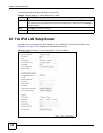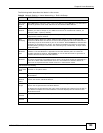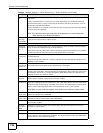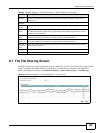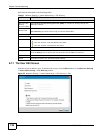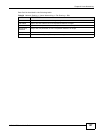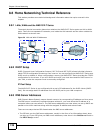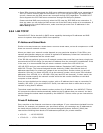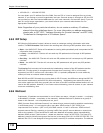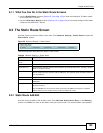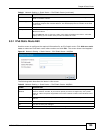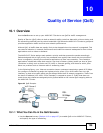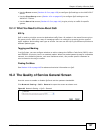
Chapter 8 Home Networking
AMG1312-T Series User’s Guide
130
• 192.168.0.0 — 192.168.255.255
You can obtain your IP address from the IANA, from an ISP or it can be assigned from a private
network. If you belong to a small organization and your Internet access is through an ISP, the ISP
can provide you with the Internet addresses for your local networks. On the other hand, if you are
part of a much larger organization, you should consult your network administrator for the
appropriate IP addresses.
Note: Regardless of your particular situation, do not create an arbitrary IP address;
always follow the guidelines above. For more information on address assignment,
please refer to RFC 1597, “Address Allocation for Private Internets” and RFC 1466,
“Guidelines for Management of IP Address Space”.
8.8.5 RIP Setup
RIP (Routing Information Protocol) allows a router to exchange routing information with other
routers. The RIP Direction field controls the sending and receiving of RIP packets. When set to:
• Both - the AMG1312-T Series will broadcast its routing table periodically and incorporate the RIP
information that it receives.
• In Only - the AMG1312-T Series will not send any RIP packets but will accept all RIP packets
received.
• Out Only - the AMG1312-T Series will send out RIP packets but will not accept any RIP packets
received.
• None - the AMG1312-T Series will not send any RIP packets and will ignore any RIP packets
received.
The Version field controls the format and the broadcasting method of the RIP packets that the
AMG1312-T Series sends (it recognizes both formats when receiving). RIP-1 is universally
supported; but RIP-2 carries more information. RIP-1 is probably adequate for most networks,
unless you have an unusual network topology.
Both RIP-2B and RIP-2M sends the routing data in RIP-2 format; the difference being that RIP-2B
uses subnet broadcasting while RIP-2M uses multicasting. Multicasting can reduce the load on
non-router machines since they generally do not listen to the RIP multicast address and so will not
receive the RIP packets. However, if one router uses multicasting, then all routers on your network
must use multicasting, also.
8.8.6 Multicast
Traditionally, IP packets are transmitted in one of either two ways - Unicast (1 sender - 1 recipient)
or Broadcast (1 sender - everybody on the network). Multicast delivers IP packets to a group of
hosts on the network - not everybody and not just 1.
IGMP (Internet Group Multicast Protocol) is a network-layer protocol used to establish membership
in a Multicast group - it is not used to carry user data. IGMP version 2 (RFC 2236) is an
improvement over version 1 (RFC 1112) but IGMP version 1 is still in wide use. IGMP version 3
supports source filtering, reporting or ignoring traffic from specific source address to a particular
host on the network. If you would like to read more detailed information about interoperability
between IGMP version 2 and version 1, please see sections 4 and 5 of RFC 2236. The class D IP
address is used to identify host groups and can be in the range 224.0.0.0 to 239.255.255.255. The
address 224.0.0.0 is not assigned to any group and is used by IP multicast computers. The address



